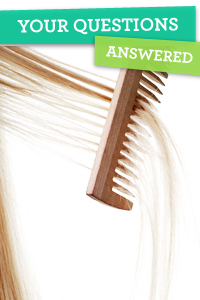 This week we have a reader-submitted question that I think many women grapple with. Take it away Beverly from Columbus, Ohio ...
This week we have a reader-submitted question that I think many women grapple with. Take it away Beverly from Columbus, Ohio ...
Question: "I used to have thick, healthy hair but it's getting much thinner and more straw-like as I get older -- what's going on and what should I do?
Answer: Beverly (and the rest of us dealing with hair changes and hair loss) needs to understand that she's not alone. Up to 40 percent of American women suffer from hair loss of some kind. There are several contributing factors, including hormonal shifts (especially during menopause), trauma and/or high levels of stress, and of course, good old heredity.
To get your hair back on track regardless of the root cause of your thinness, hair health experts suggest getting more sleep, taking vitamin B supplements, and using an intensive treatment that will strengthen the hair where it starts -- at the scalp -- because creating the healthiest scalp possible helps to stop hair breakage and encourage growth. (Try one of Nioxin's four different three-part systems that best suits your needs.)
Also, understand that as you age, your hair is bound to get harder to work with. "As women move toward menopause, textural changes and the problems they create are compounded as gray hair becomes more prominent," says celebrity hairstylist Marie Ferro. Why? Those grays have less pigment and are much more coarse than your non-gray hair, Ferro explains. Add those grays in with those strands that are thinning and you are sure to have styling difficulties.
A proactive way to minimize problems and get the best results from your hair in its current state is to use products designed for aging and thinning hair. (Try Frederic Fekkai Ageless Rejuvenating Shampoo, $35, and Frederic Fekkai Ageless Restructuring Conditioner, $35, which both work to reinforce core strength, structure and vitality of the hair.)
It's also a good idea to incorporate thinning-hair specific styling products into your regimen. Nioxin Volumizing Reflectives Root Lifter, $8, for example, will work to give each strand maximum volume and support follicles at the root to create a fuller head of hair.
It's also important to remember not to tug your hair back into a tight ponytail, as that can cause further damage and breakage. Can't stand to have your hair in your face? Try this cool, no-fuss undone bun instead.

